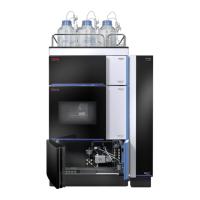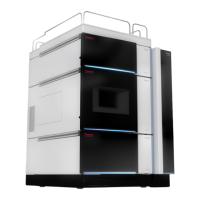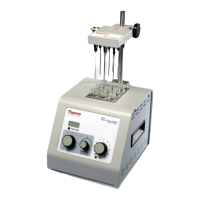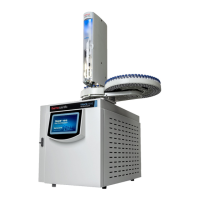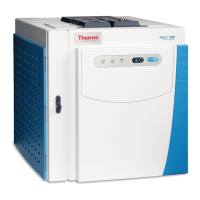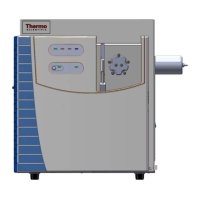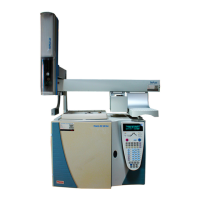
Do you have a question about the Thermo Scientific thermoscientific VC-P20-A-01 and is the answer not in the manual?
| Product Type | Vacuum Controller |
|---|---|
| Model Number | VC-P20-A-01 |
| Brand | Thermo Scientific |
| Voltage | 100-240 VAC |
| Frequency | 50/60 Hz |
| Power Consumption | 20 W |
| Display | LCD |
| Operating Temperature | 5°C to 40°C |
| Storage Temperature | -20°C to 60°C |
| Humidity Range | 20% to 80% RH (non-condensing) |
| Communication Interface | RS-232 |
Describes the manual's purpose, scope, and notes for users.
Explains safety messages, special notices, and informational notes used in the manual.
Details typographical conventions for data input, references, viewpoint, and important words.
Lists additional hardware and software documentation available for reference.
Explains safety symbols, signal words, and how to observe manual safety messages.
Lists safety symbols found on the device or labels and their meanings.
Defines the intended use of the device and recommends laboratory best practices.
Outlines general safety information and precautions for installation, operation, and transport.
Details electrical safety measures to prevent shock or damage to the device.
Warns about hazardous substances and biohazards, and provides handling precautions.
Provides instructions for emergency situations, emphasizing power disconnection.
Provides recommendations for compatible solvents and additives to ensure optimal system functionality.
Specifies allowed pH ranges for different system configurations and notes impact on detectors.
Lists allowed concentrations for chloride and buffer in different system configurations.
Details compliance with EMC and safety standards and notes that changes may void compliance.
Describes the main and special features of the Vanquish pump, including its piston design and degasser.
Explains the general and pump-specific operating principles, including dual-piston and degasser functions.
Explains how to access interior components by opening the front doors for maintenance.
Details the active piston seal wash system for prolonging piston and seal lifetime by keeping them wet.
Describes the purge/sensor unit, comprising the purge valve and system pressure sensor.
Explains the mixing system components (capillary and static mixers) and their role in baseline smoothing.
Details the leak sensor's function in monitoring leaks, alerting the user, and stopping the pump if unresolved.
Describes device operation via computer (Chromeleon) and the availability of an internal keypad for basic functions.
Provides instructions for unpacking the device, inspecting for damage, and handling heavy loads safely.
Lists the items included in the pump's delivery package.
Presents safety guidelines for installation, including handling heavy devices and electrical precautions.
Outlines the steps for installing the device hardware, flow connections, and software setup, including qualification.
Specifies environmental requirements for the installation site to ensure optimal device performance.
Explains how to access interior components by opening the front doors for maintenance.
Describes how to set up the hardware, including system arrangement and device connectors/cables.
Details the electrical connectors and device connection ports available on the pump.
Provides instructions for connecting the power cord, emphasizing correct country-specific cords and condensation prevention.
Guides on setting up flow connections, including general rules, handling components, and flushing.
Explains how to route capillaries and tubing through the system using tubing chases and guides.
Provides general guidelines and specific instructions for connecting Viper and non-Viper capillaries and tubing.
Describes how liquids collected in the leak tray are guided to the drain port and waste system.
Details how to install solvent lines between pump inlet ports and solvent reservoirs.
Provides steps for installing solvent shut-off valves in solvent lines for flow control.
Outlines the components of the seal wash system and steps for setup, interconnection, and flushing.
Lists parts and tools required and provides instructions for setting up the seal wash system.
Describes alternatives for flushing the seal wash system, including using software or manual methods.
Guides on connecting the pump and autosampler using capillaries and routing them through guide holes.
Details the procedure for turning on the device, including power button and main power switch usage.
Instructs on setting up the device within the chromatography software, referring to manuals and help files.
Introduces the chapter on device control, routine operation, and shutdown, assuming prior setup completion.
Highlights safety guidelines for operating the device, including LED luminosity and system operation precautions.
Describes the control elements, including the keypad and status indicators for device operation.
Explains the status LED bar, STATUS LED, and pump block LED for monitoring device operational status.
Details the main power switch and system power button for controlling device power, including startup sequences.
Provides guidelines for using solvents and additives to prevent system contamination and ensure optimal performance.
Covers additional steps required to prepare the device for operation and sample analysis, including first-time use.
Discusses key operating parameters like flow, flow ramps, and pressure limits for routine device operation.
Explains the purpose and settings for purging the pump, including automatic and manual procedures.
Offers information and hints to optimize device performance, including component monitoring and solvent handling.
Provides instructions for shutting down the device for short-term or long-term interruptions.
Introduces routine maintenance and service procedures that users can perform, noting service personnel requirements.
Outlines safety guidelines for performing maintenance and service, covering high voltage, hazardous substances, and solvent spraying.
Lists general rules and recommendations for successful maintenance and service procedures.
Describes routine and preventive maintenance for optimal device performance and uptime.
Explains procedures for flushing the pump to avoid contamination or address persistent contamination issues.
Details a harsher cleaning procedure for persistent contamination, including specific reagents and steps.
Describes cleaning and decontamination procedures, including safety precautions for alcoholic detergents.
Explains the Predictive Performance function in Chromeleon software for scheduling maintenance based on usage.
Outlines maintenance steps for the seal wash system, including leakage testing and component replacement.
Provides steps to test the seal wash system for leakage, especially after maintenance.
Guides on replacing seal wash lines due to damage, blockage, or regular maintenance.
Details the procedure for replacing the seal wash detector due to contamination or impaired functionality.
Lists maintenance procedures related to the pump head, including replacement of seals and pistons.
Guides on replacing the pump head due to damage or performance issues, including preparations and steps.
Details the process for replacing pistons when damaged, including cleaning and seal replacement.
Explains how to clean pistons, including inspection for damage and proper reinstallation.
Guides on replacing piston seals or support rings due to leaks or unstable flow rates.
Provides recommendations for running in new piston seals to ensure performance and longevity.
Details the procedure for replacing seal wash seals due to damage, leakage, or regular maintenance.
Guides on replacing pump head seals due to damage or leakage.
Explains how to test piston seals for leakage, especially when pressure issues are observed.
Outlines maintenance procedures for check valves, including replacement of inlet and outlet valves.
Guides on replacing outlet check valves due to damage or leakage.
Details the process for cleaning check valves using isopropanol and an ultrasonic bath.
Describes the mixing system, including testing static mixer permeability and replacement.
Guides on replacing static or capillary mixers due to permeability issues or damage.
Covers maintenance for solvent lines and filters, including emptying, replacing, and cleaning.
Details the procedure for replacing solvent lines based on pump type and flow path.
Guides on replacing solvent line filters due to damage or impaired permeability.
Details the process for replacing the purge valve knob when leakage is observed.
Provides a general test procedure to check the pump for leakage after maintenance.
Guides on replacing main power fuses, emphasizing safety precautions and correct fuse types.
Explains how to update the device firmware using the Instrument Configuration Manager and Chromeleon software.
Details how to remove and install the device doors, emphasizing careful handling to avoid hinge damage.
Prepares the device for transport or shipping, including safety guidelines.
Guides on removing and installing slide-in modules, stressing safe handling of heavy components.
Provides general information on troubleshooting, including status indicators, alarms, and audit trail messages.
Lists common messages appearing in the Chromeleon Audit Trail and their description and remedial actions.
Details tests to help identify leakage sources in the pump, such as general pump leak tests and seal leak tests.
Provides steps to resolve liquid leaks by locating the source and taking appropriate remedial action.
Addresses pressure issues and retention time shifts, guiding users to identify and eliminate problem sources.
Offers solutions for persistent air bubbles, suggesting purging against backpressure and referring to piston seal procedures.
Introduces the chapter on pump-specific information, covering interior components and operating principles.
Provides specific information on quaternary and dual pumps, including components, operating principles, and dwell volume.
Details specific information for the binary pump, including its interior components, operating principle, and solvent composition settings.
Covers specific information for the isocratic pump, including its interior components and operating principle.
Explains gradient delay volume, dwell volume, and ripple in HPLC systems and how pump mixing systems affect them.
Lists available mixing systems, their volumes, and remarks on compatibility and requirements.
Guides on removing and installing different mixing systems to adapt dwell volume or ripple.
Discusses considerations for using normal-phase compatible solvents and additives, including pump and autosampler modification.
Details performance specifications for quaternary, dual, binary, and isocratic pumps.
Lists physical specifications of the device, including operating conditions, power, dimensions, and weight.
Provides general information on operating the device with authorized parts and compatibility of updated components.
Lists the items included in the Binary Pump VC-P10 ship kit and reordering information.
Lists items included in the VC-P32/VC-P33 and VF-P32 ship kits for dual pumps.
Lists items included in the VC-P40 ship kit for the isocratic pump.
Lists items included in the VC-P20/VC-P21 and VF-P20 ship kits for quaternary pumps.
Lists optional accessories, including miscellaneous items, mixing systems, and inline filters.
Details available consumables and replacement parts, including maintenance kits for VC and VF pumps.
Provides declarations of conformity, cTUVus compliance, and RoHS compliance information for the device.
States compliance with the European Union's Waste Electrical & Electronic Equipment (WEEE) Directive.
Confirms compliance with U.S. FCC Rules for Class A digital devices.
Lists the manual revisions and the corresponding product model coverage.
Explains the functionality of digital I/O ports for exchanging signals with external devices and pin assignments.

